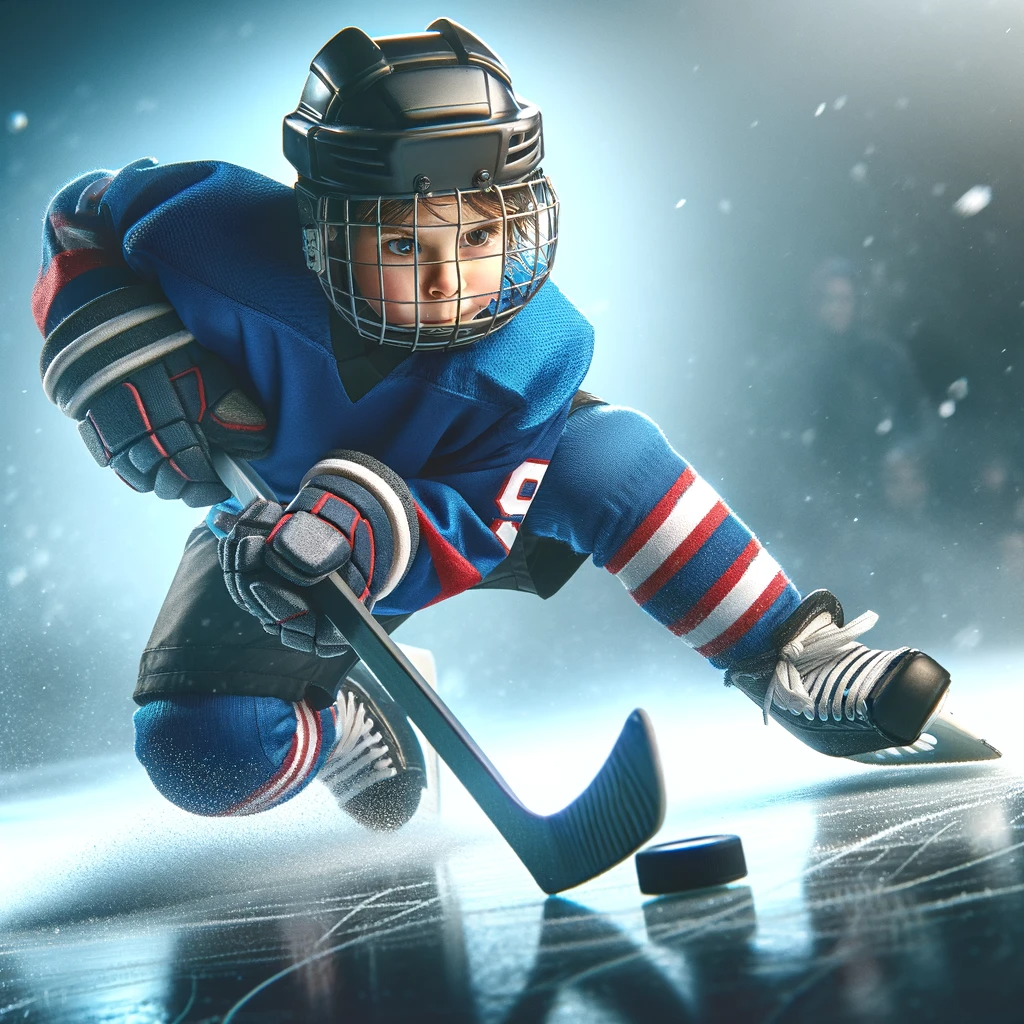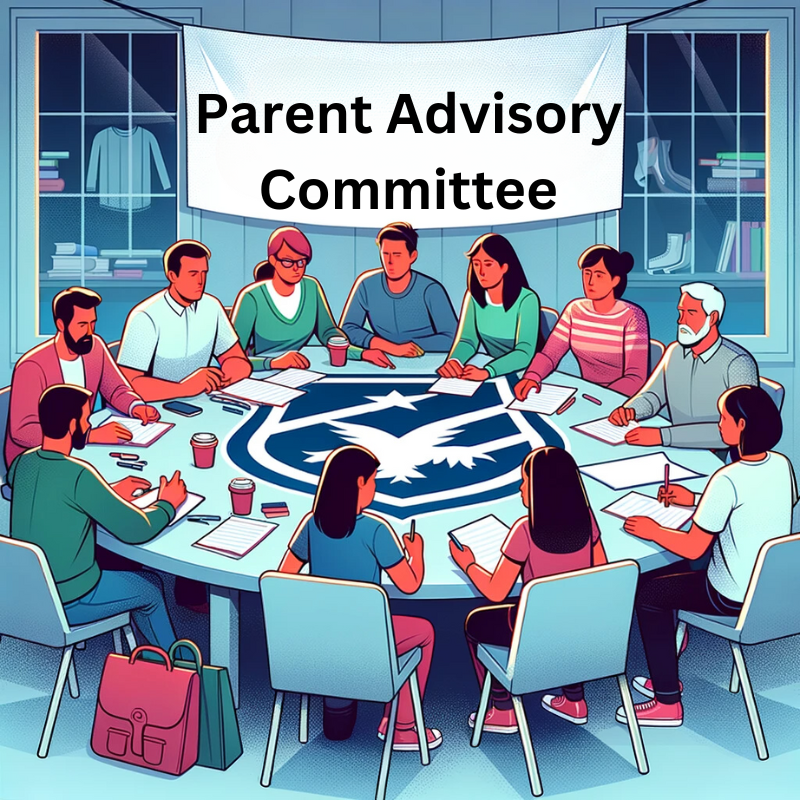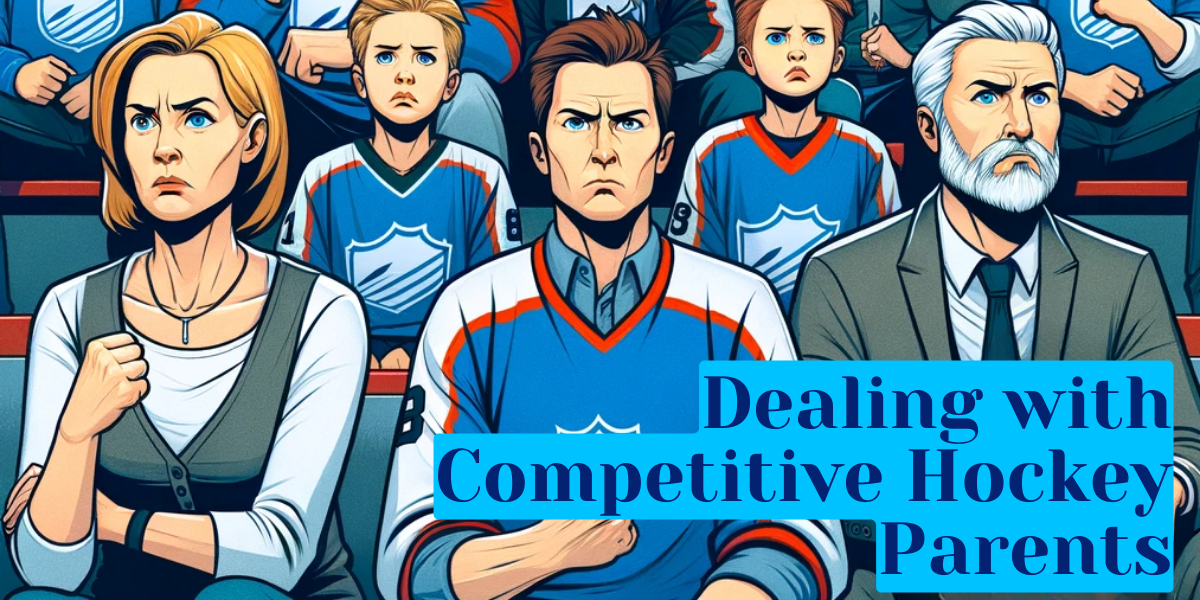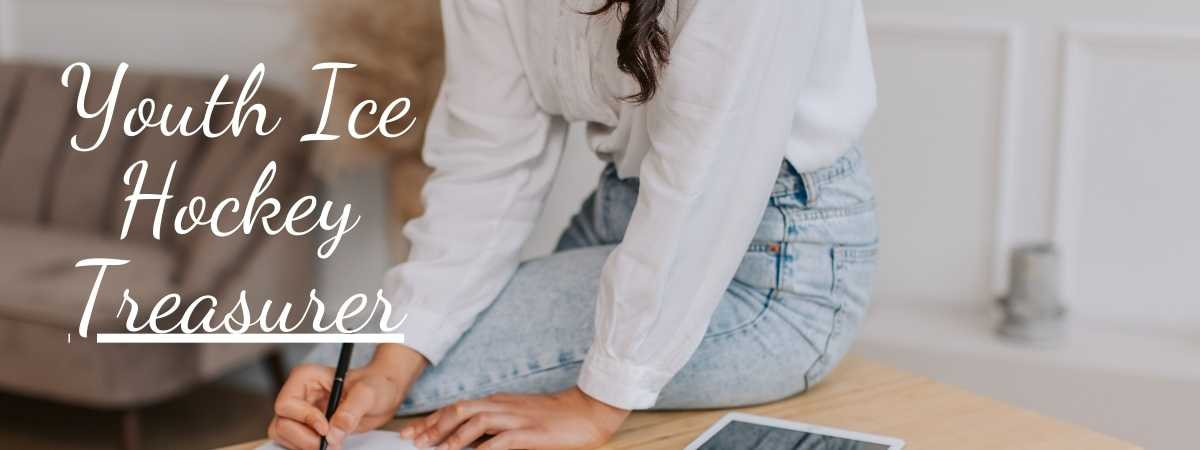Dealing with Competitive Hockey Parents: A Guide
As an experienced ice hockey parent, I fully understand the unique challenges and dynamics that come with managing competitive hockey parents. Youth Ice Hockey parents have an intense “passion” and drive that these parents have for their young athletes can sometimes lead to conflicts and tensions within the youth sports community. That’s why I’ve created this comprehensive guide to help you effectively handle and navigate through the complexities of dealing with competitive hockey parents.
Throughout this guide, I will share insights and strategies that I’ve gathered from my own personal experiences and interactions with other hockey parents, the impact on the player, the parents, the team and even the organization’s reputation.
By implementing these strategies, you will be able to create a positive and supportive environment for your young athlete while addressing any issues that may arise among parents.
The Emotional Undercurrent of Parental Competitiveness in Youth Hockey:
Does This Sound Familiar?

Underneath the dim lights of the rink, two hockey moms, Skate-Tying Susan, and Points-Counting Patty, find themselves in the midst of a conversation that’s as tense as a tied game going into overtime near the end of the present season.
Susan is meticulously watching as her son hits the ice with his line. While Patty casually leans towards Patty and cold coffee in hand.
Patty continues with a casual tone, “So, Susan, have you heard how many spots are open on the Pee Wee team this year?”
Susan looks up, offering a smile that doesn’t quite reach her eyes. “I’m not sure, Patty. I think there are a few, but you know how it is.”
Patty nods knowingly, “Yeah, I’ve been hearing rumors that the organization might already have most of the team picked out. It’s all about who you know, right?”
Susan’s smile falters for a moment, her hands still sore from tying the skates tight for the game. Her thumbs still burning from pulling those laces, line by line. The thought of try outs in a few weeks sends a ripple of anxiety through her, but she quickly masks it with a chuckle, “Well, let’s hope that’s not entirely true.”
Patty, seemingly oblivious to Susan’s discomfort, continues, “Absolutely. Though, I’m not too worried. My Jake scored 30 points this season. He’s got a pretty good shot at making the higher team.”
Internally, a storm of worry brews in Susan, not be shown. Will anyone see his effort? Does it all come down to points and who you know? she wonders, her heart sinking at the thought of her son’s hard work being overlooked.

Despite her inner turmoil, Susan maintains her composure. “That’s impressive, Patty. Jake is a great player. I guess all we can do is encourage them and hope for the best.”
Patty nods, her attention now back on the ice where her son is scoring yet another goal. “Exactly. It’s all part of the game, right?”
The conversation ends as the kids head onto the ice, the tie broken within the last minute. But, Susan is left with a lingering sense of unease, masked by a mother’s supportive smile.
She knows this is just part of the journey, but it doesn’t make it any easier.
As she watches her son, she silently cheers him on, hoping that his passion and effort shine through, no matter what the scoreboard or rumor mill says.
Understanding the Competitive Culture of Youth Hockey Parenting
In the frosty world of youth ice hockey, where the action on the ice is riveting, there’s a parallel game being played in the stands – one that involves parents and their oftentimes unconscious competitive banter.
This repeated behavior, though seemingly benign, can become as emotionally draining as a double-overtime playoff game.
Imagine this: Parents, huddled in groups, often engage in conversations that revolve around their child’s performance, team politics, and who’s likely to make the cut.

It’s like a never-ending power play, where each word and statistic is meticulously analyzed and shared.
Over time, this relentless focus on competition and comparison starts to take a toll. It’s not just exhausting; it’s like skating on thin ice, where one wrong move could lead to a crack.
Reflecting on my 11-year journey as a hockey parent, I’ve faced the inescapable truth: the culture of competitiveness in hockey is a constant. Sure, the intensity varies from year to year, influenced by the mix of parents and coaches, but the presence of parental competitiveness is something you can’t evade.
However, we can collectively backcheck this challenge with smart, strategic plays!
Understanding the Intensity of Youth Sports

Youth hockey is renowned for its high intensity, not just during the games but also in the stands. Let’s be real: hockey parents have gained a reputation as ‘crazy hockey parents.’ The terms ‘Hockey Mom’ and ‘Hockey Dad‘ often conjure up quite vivid images.
Where did this rather newer generation of parents in the last 20 years come from? And, reportedly, we are getting worse?!
The facts are my parents and their friends report that either they did not feel this pressure even IF they even did come to our games, Nor,
- Recently, parents have become more available, thanks to the shift away from traditional 9-5 job structures.
- Parents often believe that not being visibly present at their child’s sports events carries a negative stigma associated with their absence from practices and games.
- This situation opens the door for parents to engage in conversations among themselves, which can inadvertently build and amplify the pressure and anxiety to succeed.
- Amidst the rising costs of higher education, parents often harbor a secret hope that their child’s success in sports might pave the way for college assistance.
- Social media can often amplify the pressure for some parents, fostering a sense that their children must outperform their peers to stay ahead.
- The landscape of youth sports has evolved to be more demanding and intense, encompassing expenses, tuition, travel, and training. As a result, the stakes feel elevated for parents who increasingly see themselves as key stakeholders in their child’s development and achievements.
- Refer to our article for insights into the biological factors at play. Coupled with social and financial pressures, along with aspirations for success, these elements can converge into a trifecta, fueling the stereotype of the overly competitive hockey parent.
- Parents see their children as a reflection of themselves. Call in some kind of narcissistic mirroring, I am not sure, but this needs to be tempered.
- Private sports organizations increasingly mirror the world of professional athletic teams. With aspects like travel, media coverage, and video footage, these youth teams feed into the same excitement and endorphin rush we experience when discussing our favorite professional sports teams. It’s a comprehensive and immersive experience that parallels the big leagues.
- Participation in private youth sports organizations, especially travel teams and those requiring tuition, has become a symbol of status. It’s not just about sporting the team magnet on your car, wearing the merchandise during games, or donning a logo-emblazoned winter hat. In conversations with other parents, they often already know where your child plays, their tier placement, and even their seasonal point tally, owing to the online accessibility of team rosters and player statistics.
- Private sports organizations and certain trainers sometimes give the impression that every child has the potential to “make it big.” While training undoubtedly improves skills, it’s worth questioning whether it can truly elevate a B-level player to NHL standards. Realistically, it might propel them to high AA or even College D3 levels, but there are natural limits to consider, including genetics, that determine how far training alone can take each athlete.
Now, let’s bundle everything we’ve discussed: the biological, sociological, and psychological factors influencing youth sports. Picture this scenario – competing for just 3 spots on the top A team, all while navigating the complex dynamics within a close-knit circle of your child’s 10 team family friends and their parents… it’s quite an overwhelming picture, isn’t it? Yikes indeed!
I sincerely believe that most parental anxiety and pressure start with a genuine interest in an environment where their children can strive to be their inherent best and achieve the success that makes the child happy. Yet, this simple wish for success unchecked and anxiety builds and gets stacked with the constants above.
When anxiety and stress spiral out of control, the conduct of a parent who lacks self-awareness or maturity can start resembling a ruthless, win-at-all-costs competitiveness.

Recognize the Signs of Over-Competitiveness
It’s essential for us, as parents, to recognize when the spirit of competition might be edging into overdrive. If we find ourselves more fixated on victories than on the joys and personal growth of our young athletes, it’s a signal we might be pushing too hard.
Here’s the deal: our young players are on the ice not only to score goals but also to learn valuable life lessons, develop skills, and most importantly, enjoy the game. As their biggest fans, we must monitor our attitudes and actions. Are we inadvertently prioritizing winning over well-being? It’s a question worth pondering.
Our goal is to nurture not just potential sports stars but well-rounded individuals. By fostering a balanced approach to competition, where development and enjoyment go hand in hand, we can help our children excel both in sports and in life. Let’s aim to strike that perfect balance, ensuring that every game is a win-win, regardless of the score.
The Impact of Parental Influence on Youth Hockey
In the world of youth hockey, parental influence plays a significant role in shaping the development and performance of young athletes. Parents have the power to create a supportive and healthy environment that can have a lasting impact on their children’s experiences in the sport.
We know and see when parents demonstrate positive behaviors and attitudes, they can inspire and motivate their young hockey players to reach their full potential. Supportive and encouraging parents can instill confidence, resilience, and a love for the game, fostering a lifelong passion for hockey.

On the other hand, negative parental influence can have detrimental effects on young athletes. Pressuring children to excel, overly critiquing their performance, or displaying aggressive behavior can erode their self-esteem and enjoyment of the sport.
This can lead to burnout, decreased motivation, and even conflicts within the team.
| Signs of Over-Competitiveness in Parents | Impact on Young Athletes |
|---|---|
| Excessive focus on winning at all costs | Increased pressure and stress on young athletes |
| Constant criticism and unrealistic expectations | Diminished self-confidence and enjoyment of the sport |
| Overinvolvement in the athlete’s training and performance | Reduced autonomy and independence in decision-making |
It is crucial for parents to understand the impact their words and actions have on their children’s hockey journey. By being positive role models and providing constructive feedback, parents can create a safe and nurturing environment where young athletes can thrive.
Moreover, the impact of parental guidance reaches far beyond the boundaries of the rink. When parents place a strong emphasis on education, the spirit of teamwork, and the principles of sportsmanship, they play a crucial role in shaping young players into individuals equipped with important life skills. The emphasis switches from all hockey all day, every day to other needs and interests.
It’s about more than just the game; it’s about nurturing character.
Recognizing not only your child’s efforts but also those of their teammates is key to developing a supportive and respectful sports environment.
By doing this, parents significantly contribute to a healthy, positive sports culture that enriches the experience for all involved, creating a win-win scenario both on and off the ice, and yes less competitiveness and more support.
Parents need to strike a balance between being involved and allowing their children to take ownership of their hockey journey. We are the parents, but this is not our journey.
By respecting the boundaries and expertise of coaches and allowing young athletes to make their own decisions, parents empower their children to develop independence and a sense of responsibility and decrease the burden they may feel for their child to succeed. Therefore, decreasing the competitiveness and stress on you, the parent!
Ultimately, parental influence in youth hockey can be a powerful force for positive growth and development.
Handling Competitive Hockey Parents
Strategies for Mitigating Tension
Hockey, known for its competitive edge, often sees parents deeply involved in their child’s performance. This intensity can sometimes spark tension and disagreements among parents. From my experience, it’s not unusual to witness parents from the same team clashing, or subtly trying to edge out a less skilled player with a covert nod to the coach. Some even go as far as positioning themselves as assistant coaches, seeking a semblance of control and influence over the game to benefit their own child.
Honestly, I have to say, this relentless drive to push one’s child to the forefront at any cost is truly disheartening. It is when I want to turn on my heel and wish we never walked into a rink.
Yet, I often remind myself that there are effective strategies available to help reduce tension and competitive pressures.
1. Take the High Road
-
- Respond with Positivity: When faced with aggressive remarks or competitiveness from other parents, counter with positive comments about teamwork, sportsmanship, or the enjoyment of the game. This approach not only diffuses tension but also sets a constructive tone for the conversation.
- Example: “I think each child is growing at their own pace, and it’s important to celebrate their individual progress and effort.”
- Redirect the Focus: Steer the discussion away from direct competitiveness towards topics that celebrate all players’ efforts and achievements. Highlighting the value of every child’s contribution to the team can shift the conversation to a more inclusive and supportive narrative.
- Example: “It’s great to see how each child contributes in their own way. Team sports are a fantastic way for them to learn and grow together.”
- Practice Tactful Disengagement: If the conversation continues to be aggressive or overly competitive, politely excuse yourself or change the subject. Maintaining respectful boundaries protects your well-being and models mature behavior for both parents and children.
- “All the kids are doing their best. Oh, I see the coach has an announcement, let’s listen in.”
- Respond with Positivity: When faced with aggressive remarks or competitiveness from other parents, counter with positive comments about teamwork, sportsmanship, or the enjoyment of the game. This approach not only diffuses tension but also sets a constructive tone for the conversation.
2. Take an Active Role by Joining the Board or Advocating for a Parent Advisory Committee.

Having an Advisory Committee may reduce stress and competitiveness among parents by providing a structured platform for open communication and shared decision-making.
This committee serves as a liaison between parents and the organization, ensuring that concerns about competitiveness, player development, and team dynamics are addressed collaboratively.
By involving parents in the decision-making process and focusing on collective goals, it promotes a more supportive and less competitive atmosphere, aligning everyone towards the common objective of nurturing a positive and healthy environment for the young athletes.
Encouraging respectful dialogue and active listening can help defuse potentially heated situations. Parents need to express their concerns and frustrations calmly and constructively. This allows for a better understanding of differing perspectives and promotes a sense of teamwork and unity among parents.
3. Working the Corners: Navigating Competitive Dialogue Among Parents with Expertise and Ease
Remember, handling competitive parents requires patience, understanding, and a focus on the well-being of all children involved. By implementing these strategies and developing a thick skin, you can navigate these challenging situations with confidence
- Ensure that all discussions are held away from the listening range of children, and avoid engaging in any negative conversations either at home or during car rides.
- Never let them see you sweat. Approach any passive-aggressive criticisms with a rational head. Keep your cool. Even when you don’t know what to say, say nothing, nod and walk away. Leave them wondering.
- Focus on your child: Its human tendency to compare, but that will destroy your faith. Remember that your primary goal as a parent is to support and guide your child. Keep your attention on their development and well-being.
- Create Real Personal Boundaries: It’s important to establish definite physical and conversational boundaries. There have been moments when I intentionally avoided lingering around the rink before tryouts to escape the gossip and speculation. If avoiding the area isn’t an option, it’s perfectly okay to tactfully end discussions about tryouts or performance. A simple, “I really don’t know, that’s up to the coaches. I’m not in a position to guess or assume,” can effectively close that topic then and there.
- Look for Support: It’s beneficial to share your experiences and seek guidance from others, but ensure that you’re confiding in someone you genuinely trust. If it is not at the rink, maybe a forum or a trainer, someone from outside the organization but familiar with the sport.
- Another effective strategy is to focus on the big picture. Remind yourself that youth sports are about more than just winning. Recognizing that hockey is a journey and that every player progresses at their own pace can help ease tensions and reduce the pressure on both the athletes and parents.
- Developing resilience and maintaining a thick skin is crucial when dealing with competitive parents.
- It’s important to remember that everyone may not always agree, and that’s okay.
- Rather than taking criticisms personally, focus on your child’s development and growth.It truly is all individual. One season where one child develops another will in two seasons from now.
- Letting negative comments or behaviors slide off your back can help maintain a calm demeanor and prevent conflicts from escalating.
4. The Youth Hockey Organization’s Role in Decreasing Competitiveness
A final approach and hope is to look for a Hockey organization that truly fosters open dialogue among parents, something I believe should be championed by the organizations themselves. My respect for our coaches is immense; however, my comments are directed toward the organizations at large. It’s a significant responsibility to shepherd these young players and their families, creating a sense of community under their stewardship.

I recently came across an article detailing the triumphs of Minnesota High School Hockey. Think of Minnesota ice hockey as the equivalent of Texas high school football. They fill up the high school arenas there; these young athletes are hockey prodigies, often moving on to top-tier Junior Hockey and beyond. Minnesota also boasts the highest youth hockey participation rate in the U.S., according to USA Hockey.
Could the secret be in the sheer enthusiasm the sport generates, or perhaps it lies in their approach? They adopt a Community Model, something many of us from Generation X might recall fondly. Reading the article, I was transported back to my days of casually strolling with neighborhood friends to the local rec center, engaging in a variety of sports. It was a time when parental presence wasn’t a given, nor was it a disappointment if they couldn’t make it. I played on local community recreational teams, which were both accessible in my neighborhood and affordable for my family’s working-class budget.
The community-based model in youth sports, like ice hockey, inherently decreases competitiveness and stress among parents by shifting the focus from elite performance and status to inclusivity, enjoyment, and skill development. This approach:
- Promotes Accessibility and Inclusivity: By making sports more accessible to a broader range of families, regardless of financial or athletic status, it reduces the pressure to ‘keep up’ with more affluent or athletically advanced families.
- Emphasizes Enjoyment and Personal Growth: The community model prioritizes fun and personal improvement over winning at all costs. This fosters an environment where the success of each child is celebrated, irrespective of their skill level, reducing the urge for parents to push their children excessively.
- Encourages Team and Community Spirit: By focusing on the community aspect, this model strengthens bonds between families and players, creating a supportive network. When the emphasis is on team spirit and camaraderie, the drive to compete against one another diminishes.
- Balances Competition with Sportsmanship: While competition is still a component, it’s balanced with lessons in sportsmanship and teamwork. Parents are more likely to encourage their children to be good teammates and sportspersons, rather than just winners.
- Reduces Financial Stress: The lower costs associated with community-based programs relieve the financial burden on parents, which in turn reduces the pressure they might place on their children to perform, seeing the investment as needing to yield high returns in the form of elite performance.
In essence, the community-based model brings sports back to its roots – an activity for physical, social, and emotional development, rather than a high-stakes competition. This shift in perspective is key to reducing stress and competitiveness among parents.
5. Building Team Spirit Among Parents
To create a positive and supportive environment for youth hockey, fostering team spirit and camaraderie among parents is essential. When parents come together as a unified and inclusive group, it promotes a sense of community and support that extends beyond the players themselves. Here are some strategies to help build team spirit among parents:

- Seek out or suggest more Team-Building Activities before and during the season. The best are when the team gives back to the community: such as volunteer days. It is an opportunity to also see more positive character traits in our team and our parents!
- Celebrating TEAM successes is an important aspect of building team spirit. Recognizing the achievements of both players and parents fosters a positive atmosphere and reinforces the sense of collective pride. Consider organizing team parties, award ceremonies, or recognition events where parents can come together to celebrate the accomplishments of their children and the team as a whole.
- Encouraging parents to support each other in both victories and defeats helps cultivate a strong team spirit. This can be as simple as offering words of encouragement or showing empathy during challenging times.
Remember, team spirit among parents not only enhances the overall hockey experience but also sets a positive example for young athletes. By working together and supporting one another, parents contribute to a nurturing and inclusive environment that benefits everyone involved in youth hockey.
Proactive Conflict Prevention Strategies

To create a cohesive and positive environment within youth hockey organizations, it’s crucial to establish and enforce clear behavioral guidelines from the season’s outset. This approach can effectively prevent conflicts and maintain a harmonious atmosphere:
- Implement Clear Behavioral Guidelines: At the beginning of the season, the organization should clearly outline expected behaviors for parents, both at the rink and during team events. This ensures everyone is aware of the standards for conduct within the hockey community.
- Promote Open Communication: Encourage transparent and ongoing dialogue among parents, coaches, and administrators. This helps address any issues or concerns swiftly and effectively, preventing misunderstandings and conflicts.
- Emphasize Sportsmanship and Respect: Stress the importance of sportsmanship and fair play, not just among players but also within the parent community. This helps create a respectful and supportive environment, teaching young athletes and their families the value of respect and positivity.
- Foster Positive Parental Involvement: Offer opportunities for parents to engage constructively with the team, such as through volunteering, organizing events, or participating in community-building activities. This involvement should foster a sense of community and shared responsibility, enhancing the overall team spirit and cooperation among parents.
Conclusion
It is important to handle competitive hockey parents with grace and tact. Strategies for mitigating tension and developing a sense of resilience can help maintain composure in challenging situations.
Building team spirit among parents is also essential, as it creates a sense of community and support.
Inclusive team-building activities and celebrating individual and team successes can promote a positive atmosphere for everyone involved.
Ongoing education and development in sports parenting are essential, empowering parents to step back and let their child’s sports journey unfold organically.
Understanding the impact of parental influence on young athletes and cultivating a positive hockey environment are key aspects of this ongoing process.
Additionally, seeking guidance from community resources and connecting with other parents can provide valuable support and insights.
To be successful in positive parenting in hockey, a commitment to continued learning and growth is necessary. By implementing these strategies and fostering a nurturing environment, parents can empower their young athletes to thrive both on and off the ice.

If the environment turns unbearably toxic or doesn’t align with your values, remember that your investment in your child’s sports experience gives you leverage. This power lies in the tuition you pay. Consider transferring your support to an organization that better reflects these principles and fosters a more positive environment.
I truly hope such situations are uncommon, but I would never advocate for someone to remain in a club environment that causes discomfort for both the child and the family.



